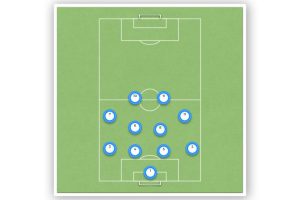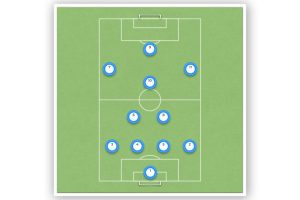The Variations of the 4-4-2 Formation: A Comprehensive Guide
The 4-4-2 formation is one of the most popular formations in soccer. It is a formation that is easy to understand and implement, making it a favorite among coaches and players alike. The formation consists of four defenders, four midfielders, and two forwards. The defenders are split into two center backs, a left back, and a right back. The midfielders are split into two center midfielders, a left winger, and a right winger. The forwards consist of two strikers, with one striker player a little bit closer to the midfield.
While the 4-4-2 formation is a simple and effective formation, there are many variations that can be employed depending on the strengths and weaknesses of the team. For example, one variation of the 4-4-2 is the diamond midfield. This variation is designed to give the team a greater number of players in the center of the field, which can be especially effective against teams that like to dominate possession. Another variation is to add more attacking players upfront, which can be useful against teams that are weak defensively.
Coaches who choose to employ the 4-4-2 formation must be aware of its strengths and weaknesses. One of the strengths of the formation is that it is easy to understand and implement, which means that players can quickly adapt to it. Another strength is that it provides clear roles and expectations for each player. However, one weakness of the formation is that it can be vulnerable to teams that play with a three-man midfield. Overall, the 4-4-2 formation is a versatile formation that can be adapted to suit the needs of any team.
The Evolution of the 4-4-2 Formation

The 4-4-2 formation is one of the most popular and successful formations in soccer history. It has undergone several adaptations and changes over time, making it one of the most versatile formations in the game. This section will explore the origins of the 4-4-2 formation and its adaptations over time.
Origins of the 4-4-2 Formation
The 4-4-2 formation was first introduced in the 1960s and quickly became popular due to its balance between attack and defense. The formation consists of four defenders, four midfielders, and two forwards. The four defenders usually consist of two center-backs and two full-backs, while the four midfielders are split into two central midfielders and two wide midfielders. The two forwards are usually a striker and a second forward or attacking midfielder.
The 4-4-2 formation was designed to provide a solid defense while also allowing for quick counter-attacks. The two forwards were able to press the opposition’s defense while the midfielders provided support and cover for the defense. This formation also allowed for quick transitions from defense to attack, making it a popular choice for teams looking to play on the counter-attack.
Adaptations over Time
Over time, the 4-4-2 formation has undergone several adaptations to suit different playing styles and opposition tactics. One of the most popular adaptations is the diamond midfield, which replaces the two wide midfielders with a defensive midfielder and an attacking midfielder. This allows for more creativity in the attack while also providing extra support for the defense.
Another adaptation is the use of a second striker instead of an attacking midfielder. This provides more attacking options and can be particularly effective against teams that play a high defensive line. The use of a second striker also allows for more flexibility in attack, with the two forwards able to interchange positions and confuse the opposition defense.
Table 1 below summarizes the key features of the 4-4-2 formation and its adaptations over time.
| Formation | Defenders | Midfielders | Forwards |
|---|---|---|---|
| 4-4-2 | 2 center-backs, 2 full-backs | 2 central midfielders, 2 wide midfielders | 1 striker, 1 second forward or attacking midfielder |
| 4-4-2 Diamond | 2 center-backs, 2 full-backs | 1 defensive midfielder, 1 central midfielder, 1 attacking midfielder, 1 wide midfielder | 1 striker, 1 second forward or attacking midfielder |
| 4-4-2 with Second Striker | 2 center-backs, 2 full-backs | 2 central midfielders, 2 wide midfielders | 2 strikers |
The Basic Principles of the 4-4-2 Formation
The 4-4-2 formation is one of the most popular and widely used formations in soccer. It consists of four defenders, four midfielders, and two forwards. The formation is versatile and can be adjusted to suit different playing styles and team strengths. The 4-4-2 formation is based on the principles of maintaining a strong defensive structure while also providing attacking options.
Defensive Responsibilities
The four defenders in the 4-4-2 formation are responsible for protecting their own goal and preventing the opposition from scoring. The two center-backs are the primary defenders and are responsible for marking the opposing forwards. The full-backs provide support to the center-backs and also contribute to the attack when the opportunity arises.
When defending, the midfielders drop back to support the defense and maintain a compact shape. The central midfielders provide additional cover to the defense and also disrupt the opposition’s attacking play by intercepting passes and making tackles.
Attacking Responsibilities
The two forwards in the 4-4-2 formation are responsible for scoring goals and creating scoring opportunities. The forwards work together to create space and opportunities for each other to score. They must also be able to hold up the ball and bring other players into the attack.
The midfielders in the 4-4-2 formation support the attack and create chances for the forwards. The central midfielders contribute to the attack by making forward runs and providing through balls to the forwards. The wide midfielders provide the attack width and contribute defensively by tracking back to help the full-backs.
Transitioning from Defense to Attack
The 4-4-2 formation is designed to facilitate quick transitions from defense to attack. When the team wins possession of the ball, the defenders look to quickly release the ball to the midfielders, who in turn look to quickly release the ball to the forwards. The forwards must be able to quickly turn defense into attack by making runs and creating scoring opportunities.
| Defensive Responsibilities | Attacking Responsibilities | Transitioning from Defense to Attack |
|---|---|---|
| Protect their own goal and prevent the opposition from scoring | Score goals and create scoring opportunities | Facilitate quick transitions from defense to attack |
| Mark opposing forwards and provide support to the center-backs | Work together to create space and opportunities for each other to score | Quickly release the ball to the midfielders and forwards |
| Drop back to support the defense and maintain a compact shape | Contribute to the attack by making forward runs and providing through balls | Quickly turn defense into attack by making runs and creating scoring opportunities |
Variations of the 4-4-2 Formation
The 4-4-2 formation is a classic formation that has been used in football for many years. It is a versatile formation that can be used in many different ways, and there are several variations of the formation that coaches can use to suit their team’s strengths and weaknesses.
The Flat 4-4-2 Formation
The most common variation of the 4-4-2 formation is the flat 4-4-2. In this formation, the four midfielders play in a flat line across the middle of the pitch, with two central midfielders and two wide midfielders. The two strikers play up front, with one playing slightly deeper than the other.
The flat 4-4-2 is a balanced formation that provides good defensive cover while also allowing the team to attack effectively. The two central midfielders can provide cover for the defense, while the wide midfielders can provide width and support for the strikers.
The Diamond 4-4-2 Formation
The diamond 4-4-2 is another variation of the 4-4-2 formation. In this formation, the midfielders play in a diamond shape, with one central midfielder playing behind the strikers and two wide midfielders playing further back on the pitch. The other central midfielder plays deeper, providing cover for the defense.
The diamond 4-4-2 is a more attacking formation than the flat 4-4-2, as it allows the team to play with more players in the attacking third of the pitch. However, it can also leave the defense more exposed, as there are fewer players covering the back four.
The Wide 4-4-2 Formation
The wide 4-4-2 is a variation of the 4-4-2 that focuses on providing width and support for the strikers. In this formation, the two wide midfielders play very wide, almost like wingers, and the central midfielders play slightly deeper to provide cover for the defense.
The wide 4-4-2 is a good formation to use if the team has fast, skillful wingers who can beat defenders and provide good crosses into the box. However, it can leave the team vulnerable to counter-attacks, as there are fewer players covering the defense.
| Formation | Pros | Cons |
|---|---|---|
| Flat 4-4-2 | Good defensive cover, balanced formation | Can be predictable, lacks attacking options |
| Diamond 4-4-2 | More attacking options, good for possession-based play | Leaves defense more exposed, can be narrow |
| Wide 4-4-2 | Provides width and support for strikers, good for counter-attacking | Can be vulnerable to counter-attacks, lacks central midfield cover |
The Advantages and Disadvantages of the 4-4-2 Formation
Advantages
The 4-4-2 formation is a popular formation in soccer that offers several advantages to teams that use it. Some of the advantages of the 4-4-2 formation include:
- Strong Defense: The 4-4-2 formation provides a strong defensive structure with four defenders, four midfielders, and two forwards. This structure allows the team to cover the majority of the space along the horizontal lines on a football pitch, making it difficult for the opposition to penetrate the defense.
- Compact Shape: The 4-4-2 formation creates a compact shape that is difficult for the opposition to break down. The team can defend as a unit, making it difficult for the opposition to find gaps in the defense.
- Counter-Attacking: The 4-4-2 formation is well-suited for counter-attacking. The team can quickly transition from defense to attack, using the two forwards to launch quick and effective counter-attacks.
- Simple Structure: The 4-4-2 formation is a simple structure that is easy to understand and implement. This makes it a popular choice for teams at all levels of the game.
Disadvantages
While the 4-4-2 formation offers several advantages, it also has some disadvantages. Some of the disadvantages of the 4-4-2 formation include:
- Lack of Creativity: The 4-4-2 formation can be a rigid structure that lacks creativity. Teams that use this formation may struggle to break down opposition defenses that sit deep and defend in numbers.
- Weakness in Midfield: The 4-4-2 formation can be vulnerable in midfield. With only four midfielders, teams that use this formation may struggle to control the midfield and maintain possession of the ball.
- Dependence on Fullbacks: The 4-4-2 formation relies heavily on the fullbacks to provide width in attack and cover in defense. If the fullbacks are not up to the task, the team may struggle to create chances in attack and defend effectively.
- Surrendering Possession: The 4-4-2 formation can make it difficult for teams to maintain control over a game, especially when it comes to dominating possession. Often, they will have to surrender the ball to the opposition for large parts of the game, acting with discipline and waiting for the right moment to pounce.
| Advantages | Disadvantages |
|---|---|
| Strong Defense | Lack of Creativity |
| Compact Shape | Weakness in Midfield |
| Counter-Attacking | Dependence on Fullbacks |
| Simple Structure | Surrendering Possession |
Conclusion
The 4-4-2 formation is one of the most popular and versatile formations in soccer. It has been used by many successful teams over the years, and its variations have helped teams adapt to different situations and opponents.
As we have seen, there are several variations of the 4-4-2 formation, each with its own strengths and weaknesses. The diamond 4-4-2, for example, is a more attacking formation that allows for greater control of the midfield, while the flat 4-4-2 is a more defensive formation that relies on quick counterattacks.
| Variation | Strengths | Weaknesses |
|---|---|---|
| Diamond 4-4-2 | Strong midfield control, more attacking | Weaker defense, vulnerable to counterattacks |
| Flat 4-4-2 | Strong defense, quick counterattacks | Weaker midfield control, less attacking |
| Wide 4-4-2 | Strong width, good for crossing and wingers | Less central control, vulnerable to counterattacks |
Ultimately, the success of the 4-4-2 formation depends on the players and the tactics used. Coaches must carefully consider their team’s strengths and weaknesses and choose the variation that best suits their style of play and the opponent they are facing. With the right players and tactics, the 4-4-2 formation can be a powerful weapon on the soccer field.





